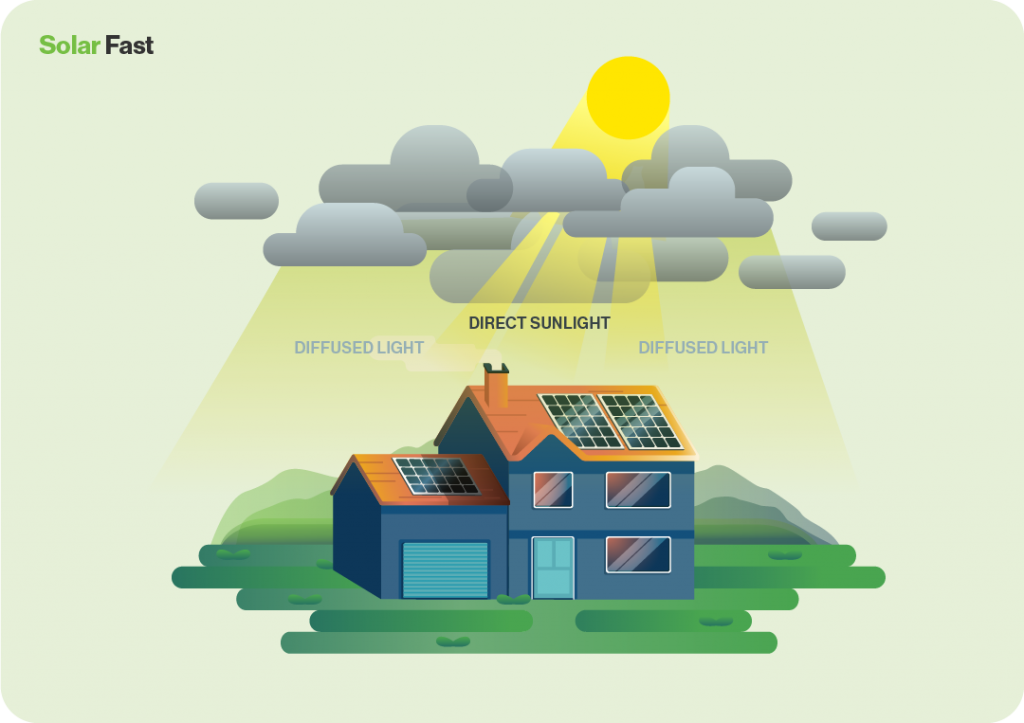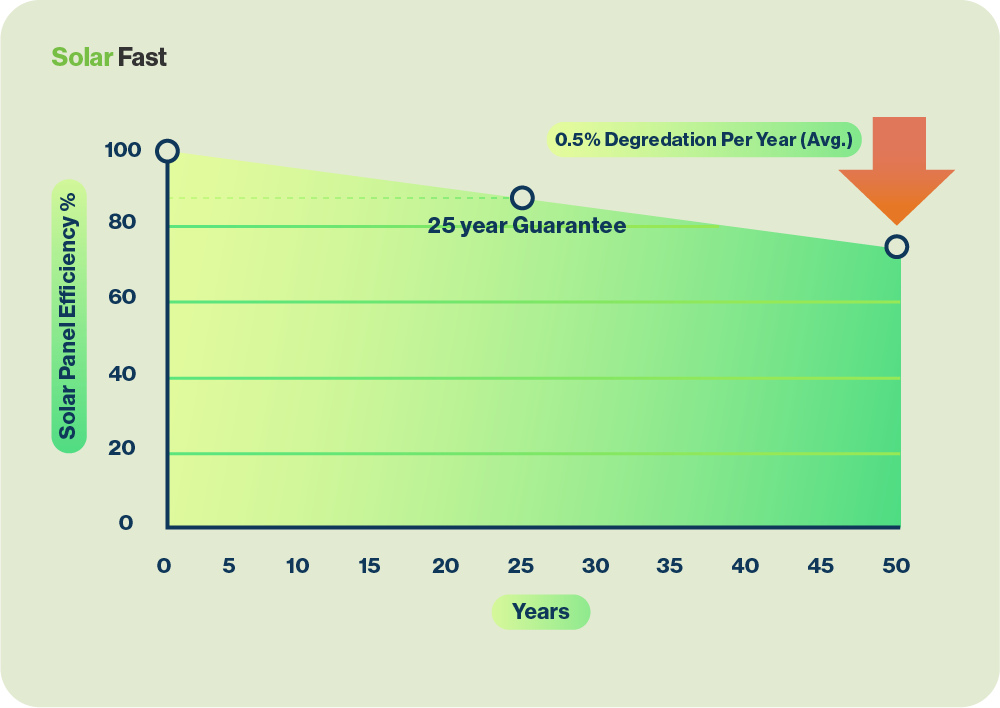The solar power sector gets a fair amount of misrepresentation considering it’s one of the fastest growing renewable sources of electricity.
One reason for some of the negative claims about solar is the worry within the fossil fuel industry that they will start to lose their market share.
We’re not talking about some massive conspiracy about ‘Big Oil’, just a normal kind of market war you will always get as new tech emerges and threatens the status quo.
Not that Solar is new in terms of technology, but it is certainly booming in the domestic market.
We can see that the energy providers are now getting on board with solar, but some of those myths just won’t die, so let’s put a few of these misconceptions to rest for good.
MYTH: The British weather doesn’t give us enough sun for solar panels.
FACT – It does you know!
While most Brits would readily agree with this statement as they look out of the window at another grey day, solar panels do not need sunshine to work.
Daylight is the watchword that we need here because that is more than enough to get the photons bouncing and the electricity flowing from your panels.
Even when it’s cloudy we, and therefore your panels, are being bombarded by sunlight in the form of portions. In fact, the cloud diffuses that sunlight so its more spread around and easier for panels to ‘absorb’.
Also, if panels get too warm, over 40 degrees, they start to become less efficient due to resistance building up inside the solar crystals.
What this means is, the Northern European weather is great for generating electricity via solar.
MYTH: Solar Panels have to face south.
FACT – That’s not a thing.
While it is true, in the Nothern Hemisphere, south facing panels get the strongest rays of light, panels facing other directions get plenty of rays too.
The angle that light rays hit the panel determine how efficiently that light can be turned into electricity.
So, if the panels are facing Southwest or Southeast, they will be functioning at almost full efficiency.
The closer the panels get to facing north, the less efficient they will become, but they will always produce electricity.
Even if the panels were facing north, they would still get light through diffusion and reflection – but you wouldn’t be able to generate a great deal of energy.
Learn more about solar panel angles.

MYTH: Solar Panels don’t work when it’s cloudy.
FACT – They totally do
Solar panels will work just fine when it’s cloudy, when it’s snowing, when it’s raining, or when it’s hailing.
As we covered in the ‘sunshine’ myth, solar panels don’t need direct sunlight to work, they work on solar radiation. In other words, when you can.
Yes, they do, solar panels also work in the rain, snow and even hail, obviously settled snow will impact the energy production more than rain.
Solar panels work through capturing solar radiation rather than actual sunlight so they will even work in the cold and cloudy days.
They will work when it’s raining, hailing, snowing or when the sun is cracking the flags!
Learn more about do solar panels work on cloudy days.

MYTH: Solar Panels suffer in extreme weather.
FACT: Nope!
Solar Panels are slabs of steel, silicon and toughened safety glass, with no moving parts, so the weather is going to have to get pretty rough to damage them!
Truth is that solar panels go through some pretty robust tests before they are allowed out of the factory.
Panels generally work best between 15 °C and 35 ° but they are subjected to temperatures of up to 65°C and as low as -10°C, so you can be sure they aren’t affected by heat.
They are shock-tested, drop tested, hurricane and hail tested. They are made to withstand winds of up to 140mph, which is a speed you are very unlikely to see here in the UK.
MYTH: Solar Power is only generated in Summer
FACT: Not even close to being true.
This is demonstrably nonsense, or it’d be a pointless endeavour to have solar farms, solar lights in the garden or solar powered road signs, never mind a solar energy system.
As it happens, depending on the kind weather we are getting, Spring and Autumn are the best time to generate solar energy because of something called the power temperature coefficient.
Silicon, the magic ingredient in solar panels, becomes more resistant to electricity the hotter it gets. When extreme temperatures are recorded in summer this means the panel will slightly less efficient.
MYTH: Solar Panels are a bad investment.
FACT: Who told you that, BP?
It’s often said that this is because of past experience with solar, government scheme and selling energy back to the grid, but we’re pretty sure it was never true.
While installing solar isn’t going to make you a millionaire overnight, it’s certainly going to save you a lot of money in the long run.
Panels last on average 40 years, while inverters and batteries are usually good for over a decade – so your system should pay for itself before any of your warranties run out. How many things in your home can you say that about?
MYTH: You need a government grant to afford solar.
FACT: If this was true, no one would have Solar in the UK!
There aren’t any grants available anymore.
This is worth saying as many companies are fishing people by claiming they can secure grants and provide free panels, so avoid this kind of scheme.
The grants system did a bit of a number of solar energy because people went a bit crazy thinking it was a never-ending goldmine of energy and cash.
Things are more regulated and much safer these days.
Obviously, you can get finance on a solar energy system in much the same way you would on a car or an extension.
Also, the new EVO4 scheme includes grants for solar if you qualify at a local level.
MYTH: You can’t have solar unless you own your roof.
FACT: Yes, yes you can.
Obviously, you’d have to get permission from whoever owns the roof, say if you are a lease holder on a flat, but there are no legal or installation barriers to fitting solar on a roof you have access to but don’t own.
Obviously, you would need to ensure that you were contracted to live in the property long enough to see a return on your investment.
Your landlord may be interested in investing in the property with you too, so it’s always worth asking.
MYTH: Solar Panels need a lot of maintenance.
FACT: They pretty much need none at all!
Solar Panels have no moving parts so there is, literally, zero wear and tear on the internal workings.
Silicon does degrade, and there is nothing we can do about that, but it takes a long time to make any difference as the rate of efficiency only goes down by 0.05% per year.
Learn more about solar panel maintenance.
MYTH: Solar Panels damage people’s roofs.
FACT: Installers and animals damage people’s roofs!
Panels are installed using specially designed frames that are developed to fit perfectly on your roof.
Installers may move a tile or two to get the frame to sit right, but they will replace them exactly as they were.
The company rep should also do a visual check on your roof to ensure it’s safe for the installers to work on – and the installer will also make sure everything is in good order.
Learn more about can solar panels damage your roof.
MYTH: Solar installations cause a lot of hassle.
FACT: Not as far as we’ve found!
Any major renovation or change to your house is going to cause a little disruption but, with a solar installation, that’s usually limited to having scaffolding around your home for a couple of days.
Once the panels are installed on the roof there will be a few hours of feeding cables to the inverter and battery – but that’s about it for inconvenience.
MYTH: Solar Panels require planning permission.
FACT: Not unless you live in a 15th Century Manor House!
Well, unless you live in any listed or protected building actually.
If you don’t then you are good to go.
That said, the installer will have to adhere to certain regulations to ensure the panels are fitted correctly, safe and in line with the surrounding aesthetics.
MYTH: Solar Panels have a bigger carbon footprint than they negate
FACT: This may be oil, coal and gas companies at it again.
We’re not saying that solar panels are 100% carbon neutral, they can’t be because the materials that are used in them need to be mined, manufactured and transported.
The carbon footprint for a solar panel comes in at about 50g of carbon over the lifetime of that panel.
That means it will take about 2 to 3 years for your panels to become carbon neutral when used in an average home set up.
MYTH: Solar Panels can’t be recycled when they are done with.
FACT: You know what? They can.
Solar Panels are not made from mystery materials that confound, confuse and distress recycling companies.
They are made, mostly, from metal, glass and silicon. All of those materials are regularly, and quite lucratively, recycled.
This myth has gained traction because councils and companies didn’t offer any services to recycle panels because it was costly to disassemble them and separate all the components.
However, like every other industry, as the demands for solar increased other companies popped up to service the sector.
Specialist transport, panel factories, packaging companies and, of course, solar panel recycling companies.
Learn more about solar panel recycling.
MYTH: Solar Panels do not look nice.
FACT: Depends what you buy!
Old polycrystalline panels look like blue chequerboard so we can agree they weren’t the prettiest thing you could put on your roof. Whereas modern monocrystalline panels are black, shiny and look sleek as you like!
At the end of the day, it’s all about personal taste.
We know people in cities are less likely to be worried about what their roofs look like, and you wouldn’t want to cover a thatched roof in panels, but we do think new panels are pretty cool looking.
MYTH: Solar Panels don’t last very long
FACT: This could not be more wrong!
Solar Panels have no moving parts, and the materials in them are pretty much indestructible unless you take a hammer to them.
The silicon loses its efficiency as the years go by, at a rate of 0.05% but that makes little difference in the first 30 years!
Manufacturers will give a solar panel a 30-year performance warranty and if a company will do that, you can be sure the item will last a great deal longer!








